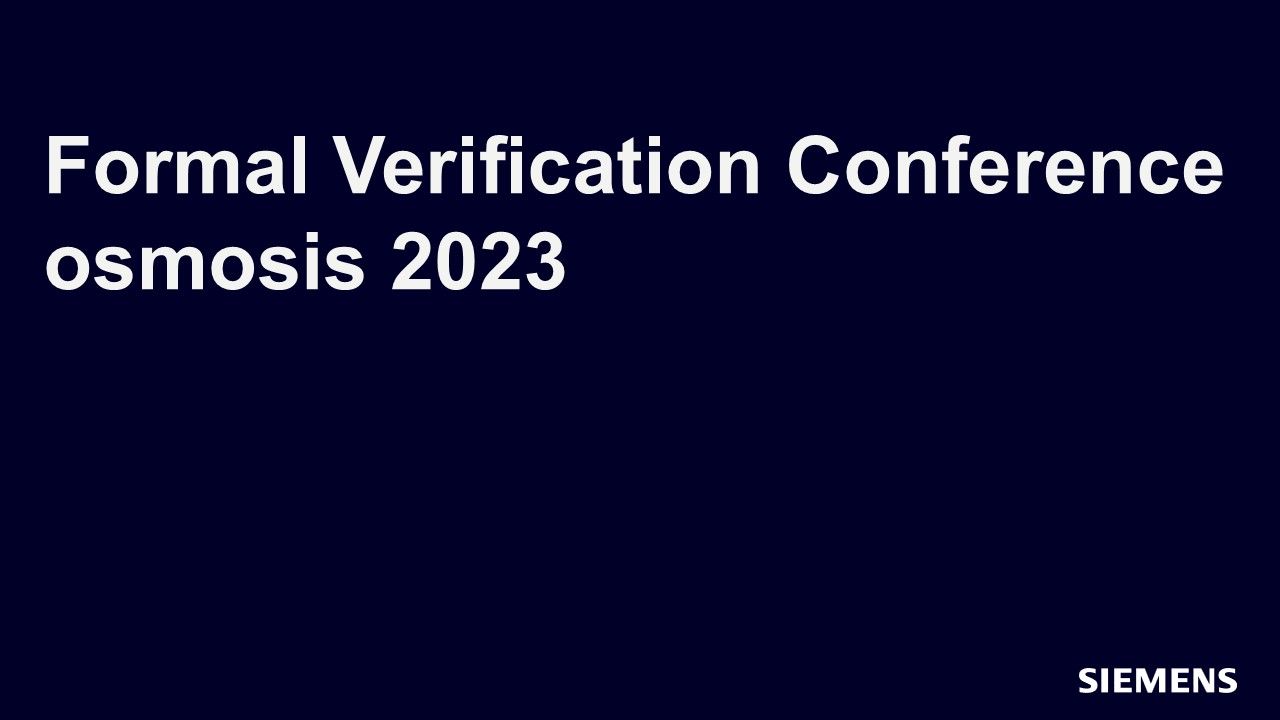Search Results
Filters
Advanced Search
2173 Results
-
Reducing Formal Verification Runtime in SystemC Utilizing Modular Interface
Resource (Recording) - Nov 16, 2023 by Hideki Kazama - Sony
-
Debugging enhancements for formal property checking
Resource (Slides (.PDF)) - Nov 16, 2023 by Holger Busch - Infineon
-
Satinder Paul Singh - CGNT
Resource (Interview) - Nov 16, 2023 by Satinder Paul Singh - CGNT
Interview with Dusica Glisic of Veriest about the value of attending Osmosis.
-
Martin Gut - Bosch Sensortec
Resource (Interview) - Nov 16, 2023 by Martin Gut - Bosch Sensortec
Interview with Martin Gut of Bosch Sensortec about the value of learning from Osmosis different formal verification approaches.
-
How formal methods could banish the ghosts that haunt our computing systems
Resource (Recording) - Nov 16, 2023 by Prof. Wolfgang Kunz - RPTU
-
Safeguarding Datapath Integrity and Compliance with Formal Security Verification
Resource (Recording) - Nov 16, 2023 by Keerthi Devraj
-
Mamma Benmoussa Garsault - Arcys
Resource (Interview) - Nov 16, 2023 by Mamma Benmoussa Garsault - Arcys
Presenter Mamma Benmoussa Garsault on the value of interactive presentations and discussions with other formal practitioners.
-
Combined Formal and Functional Verification Approach for Digitally Controlled Analog Frontend
Resource (Slides (.PDF)) - Nov 16, 2023 by Mihajlo Katona - Veriest
-
Limits of verification: learnings from catastrophic system failures
Resource (Recording) - Nov 16, 2023 by Philippe Luc - Codasip
-
How formal methods could banish the ghosts that haunt our computing systems
Resource (Slides (.PDF)) - Nov 16, 2023 by Prof. Wolfgang Kunz - RPTU
-
Prof. Wolfgang Kunz - RPTU & Tobias Ludwig - Lubis EDA
Resource (Interview) - Nov 16, 2023 by Prof. Wolfgang Kunz of RPTU and Tobias Ludwig of Lubis EDA
Presenters Prof. Wolfgang Kunz of RPTU and Tobias Ludwig of Lubis EDA on future trends and applications of formal verification.
-
Hierarchical Verification Flow for FPGA Design Projects
Resource (Recording) - Nov 16, 2023 by Mamma Benmoussa Garsault - Arcys
-
How to sign-off cryptographic hash implementations with generated formal assertions
Resource (Recording) - Nov 16, 2023 by Tobias Ludwig - Lubis EDA
-
Debugging Enhancements for Formal Property Checking
Resource (Recording) - Nov 16, 2023 by Holger Busch - Infineon
-

osmosis 2023
Conference - Nov 16, 2023 by Nicolae Tusinschi
osmosis is about sharing success in using formal techniques to solve verification challenges, and networking with our R&D experts and other attendees.
-
Prevent Performance Problems with Prompt RTL Profiling
Resource (Slides (.PDF)) - Nov 09, 2023 by Rich Edelman
In this webinar, we will show how you can employ this capability from the software world to optimize Verilog, SystemVerilog, or VHDL code for RTL simulations.
-

Prevent Performance Problems with Prompt RTL Profiling
Webinar - Nov 09, 2023 by Rich Edelman
Code profiling is a technique to identify performance issues in software code, helping developers understand how code is being executed, and identifying inefficient “hot spots” that are disproportionately impacting the code’s wall-clock run-time and memory usage.
-
Smart Verification, Faster is not enough!
Resource (Slides (.PDF)) - Oct 30, 2023 by Harry Foster
Welcome to the dawn of EDA 4.0, a groundbreaking era marked by a profound revolution in electronic design automation, all propelled by the incredible capabilities of artificial intelligence. In this presentation, we'll embark on a captivating journey through the technological ages, beginning with the era of electrification and culminating in the era of cognification.
-
Verify designs created in MATLAB or Simulink within subsystem or full-chip UVM simulations
Resource (Slides (.PDF)) - Oct 30, 2023 by Bob Oden
ASIC’s and FPGA’s increasingly include DSP, algorithm, AI, and ML blocks created using MATLAB or Simulink. Simulating these blocks within the context of adjacent RTL is required for verifying integration and system performance. Cooperation between Mathworks and Siemens has produced an automated flow for verifying these blocks within subsystem and full chip UVM based simulation environments.
-
When it Comes to Artificial Intelligence and Machine Learning, Siemens Has You Covered
Resource (Slides (.PDF)) - Oct 30, 2023 by Tom Fitzpatrick
You may have been told many different things about what AI/ML can do in the area of functional verification, but this presentation will give you the real story. Beginning with an overview of what AI/ML actually means and what technology is actually available today, we’ll explore many of the ways that we’re incorporating this exciting technology across our product portfolio.
-
Industry Trends in Functional Verification!
Resource (Slides (.PDF)) - Oct 30, 2023 by Harry Foster
This talk unveils the outcomes of a comprehensive two-decade-long double-blind industry study focusing on the functional verification of Application-Specific Integrated Circuit (ASIC) and Field-Programmable Gate Array (FPGA) designs, with a focus on the aerospace and defense markets. The insights derived from this extensive research shed light on a myriad of pressing challenges, notably the growing prevalence of bug escapes into production and the persistent issue of missed project schedules.
-
Success with Continuous Integration and Continuous Development (CI/CD) Pipeline using automated checking
Resource (Slides (.PDF)) - Oct 30, 2023 by Afzal Usmani - Siemens EDA
Mistakes happen, but finding and fixing issues late in programs increases overall program scope, as well as schedule and resource requirements. Competitive pressures push teams constantly to do more. Functional verification teams face significant challenges to build testbenches quickly, uncover design issues and enable rapid debug. Incomplete or incorrect bug fixes (or even a hurried introduction of new bugs) compound the problem.
-

MARLUG - 2023
Seminar - Oct 30, 2023 by Harry Foster
User2User Mid-Atlantic is your opportunity to learn, grow and connect with fellow technical experts who design leading-edge products using Siemens EDA tools.
-
Selective hardening in space applications
Resource (Verification Horizons Blog) - Oct 24, 2023 by Jacob Wiltgen
The space sector continues to experience disruption as innovation drives the creation of new business models across government and commercial entities. Low Earth Orbit (LEO) constellations, Traffic and Management applications, and advanced communication systems are just a few examples where innovation is driving the next generation of semiconductor development targeted for space based applications.
-
Similar but Different – The Tale of Transient and Permanent Faults
Resource (Paper (.PDF)) - Oct 18, 2023 by Charles Battikha
This paper highlights the fundamental differences between permanent and transient faults on digital circuits, and why this distinction is important in the context of the ISO 26262:2018 functional safety standard.